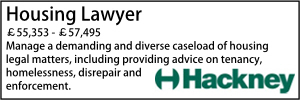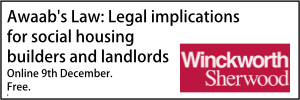Reviewing the risks facing the social housing sector
- Details
Jo Loake summarises the key points from the Sector risk profile 2020 issued by the Regulator of Social Housing.
Strategy
As a result of the diverse pressures faced by registered providers, and a need to balance the needs of current tenants and demand for more social housing, debt has increased and the Regulator of Social Housing says that it is seeing the cross-subsidy model reaching its limits. This means that registered providers face some difficult decisions in relation to raising funds in non-traditional ways and ensuring that those decisions are considered and justified and that any risks are mitigated and managed.
Boards are key. Boards set the strategy and it is crucial that they have the right skills to be able to understand and challenge the information presented to them, as well as assess where decisions for one area of business may mean a trade-off elsewhere, or may crystallise other risks. Contingency should also be considered for matters such as changes in the operating environment.
It is incumbent on registered providers’ executive teams to ensure that the information the board receives is high quality, robust and accurate. Governance arrangements must ensure effective control of operations and oversight of decision-making, including in unregistered or non-charitable subsidiaries. Boards must establish their risk appetite, which is to be informed by stress testing and by a clear understanding of the RP’s assets and liabilities
Board members need to be certain that they understand the potential consequences for their organisation, and the sector as a whole, of their decisions and that they are answerable to a myriad of regulatory bodies, as well as current and future tenants. Clear and detailed understanding of the role of the board is critical. It is provider boards that are ultimately accountable.
Registered providers must also take measures to ensure that they comply with their code of governance, including any updated codes.
Actions
- Check your code of governance is still up to date and that you comply
- Provide training to your board on the duties, liabilities, obligations and responsibilities of the members
- Review your risk management and stress testing policies and procedures
- Carry out board and board member appraisals
Reputation, complaints and safety
Reputational risk needs to be a considered factor. This is not restricted to an organisation’s own reputation but also that of the sector. The sector has been under significantly more scrutiny over the last couple of years and will continue to be so, with the focus moving more towards tenant voices being heard, and things such as excessive pay and payoffs, incorrect rent setting, data breaches, poor complaints handling, building safety and stock quality have all recently led to criticism of providers from stakeholders. Registered providers must ensure that reputational risks are mitigated and managed and that they have clear complaint handling and whistleblowing policies and procedures in place.
The Social Housing White Paper has also increased the expectations of registered providers and boards will need to ensure that they can manage service delivery risks and their obligations under the consumer standards, as well as preparing for a new regulatory and policy environment.
Ensuring tenants’ safety is paramount for registered providers and they must comply with statutory health and safety obligations, such as gas, electrical and fire safety, asbestos, legionella, and lifts. The consumer regulation review listed some key themes for health and safety compliance, but ultimately the regulator expects registered providers to understand the legal requirements. This includes acting on any outcomes identified in checks, in order to prevent risks to tenants and registered providers’ responsibilities where housing management services are delivered by a third party. It also highlights the importance of oversight and internal controls.
There are also wide-ranging changes in the draft Building Safety Bill, including the establishment of a new Building Safety Regulator. Registered providers will need to understand their responsibilities under this new regime and put in place comprehensive and effective building safety systems and programmes to ensure the safety of their buildings and their tenants.
Specifically, the risk sector profile makes reference to major works as follows:
“Boards must understand the costs associated with the replacement of flammable materials and any implications on other planned major repairs expenditure, particularly for large and complex buildings. Boards must ensure that they have a detailed understanding of their stock, underpinned by good quality data, in order to effectively manage risks to health and safety.”
Actions
- Review complaint and whistleblowing procedures
- Cross check with the Housing Ombudsman’s Complaint Handling Code 6 by the end of the year
- Carry out ‘lessons learned’ reviews
- Assess compliance with the consumer standards
- Ensure staff and boards are up to date on the consumer regulation review, the white paper and the Building Safety Bill and the impact of each
- Carry out health and safety assessments against the draft Building Safety Bill
Diversification
Many registered providers have diversified their activities in order to cross-subsidise the continued provision of social housing, but with diversification comes increased risk. Boards must ensure that they have the requisite skills, information and advice to accurately assess diversifying into a new business stream and must understand the full range of risks to which they may be exposed. Any diversification must have a clear strategic role in meeting the RP’s purpose and objectives and there must be a clear understanding of the potential risks associated with the finance and group structures related to non-social housing activities. Charitable registered providers must also have regard to charity law.
It is incumbent that boards have in place the right governance structures and ring-fencing arrangements to ensure that social housing assets are not put at risk by, for example, guarantees or impairment relating to non-social assets and the regulator will seek assurance that the risks associated with any non-social housing activities are commensurate to the reward that they achieve or that they make a clear contribution to a registered providers’ core purpose, and that social housing is not put at undue risk.
Actions
- Review group structures
- Refresh boards’ and teams’ awareness of the objects of your organisation
- Arrange some training in relation to charity law and diversification
- Review risk management strategies in relation to diversification and any potential risk posed to social housing assets
Counterparty risks
Registered providers often have contracts with a wide range of third parties, including funders, construction and maintenance contractors, care providers and joint ventures and other forms of partnership arrangements. However, the delivery of these services through third parties can expose registered providers to counterparty risk.
Boards are ultimately responsible for complying with consumer standards, even if the service has been outsourced and so it is for boards to make sure that any outsourced or contracted out services are properly managed and monitored, that third parties are subject to adequate due diligence, that advice is taken on contractual terms, as well as matters which cannot be outsourced, that there are sufficient protections in place in relation to breaches and termination, and overall that any such contracts do not breach regulation, law, policy or represent unnecessary risks, including reputational.
Actions
- Review contracts with third parties for robustness and protections
- Check whether monitoring provisions in contracts are being complied with
- Check whether any contracts have overrun or should have terminated
- Review what activities you can outsource/bring in house
Development
Development is still key to the Government. However, registered providers must be cautious in respect of the potential risks which development presents, such as financial viability, especially in respect of how development is funded and usual risks associated with the delivery. Registered providers often rely on cross-subsidy to ensure viability, from grant, sales revenues, s106 agreements, or other sources and boards need to understand the risks associated with funding development and mitigate risks related to development debt or sales. There are also risks in changing housing markets, the tenure of schemes being developed and the various planning reforms contained in the white paper that should be considered.
As well as these risks, boards must also consider the construction risks, especially with regard to building safety and construction methods.
Actions
- Consider current development programmes in the current climate to assess potential risks
- Look at future proofing any contracts being negotiated in terms of changes to safety and planning
- Check contracts being negotiated for provisions in cases of default or disruption
The regulator writes:
“The forecast reduction in development for sale has the potential to reduce the level of sales risk to which some providers are exposed. However, sustaining forecast levels of investment in both new supply and existing stock at the same time is likely to put increased pressure on other funding sources. It is important that Boards understand the wider ramifications of this change for their overall business plans, and effectively manage the effects on development risk and debt. For example, some providers forecast maintaining previously planned levels of development for rent by replacing foregone sales receipts with increased levels of debt. Whilst mitigating sales risk, this approach will increase the importance of effective treasury management.”
Other themes
There are a number of additional matters mentioned in the profile. However, we have not gone into the detail of each and every one, but a few highlights are below. We can of course advise on these matters and if you would like more information, please do get in touch.
- Quality of existing stock and review using robust and accurate data, with a possible review of the decent homes standard.
- Consideration and assessment of investment levels in existing stock
- Energy performance of existing stock
- Funding risks in relation to supported housing
- Compliance in rent setting
- Managing liquidity
- Monitoring loan covenants and potential breaches
- Robustness and risk in relation to new debt or alternative funding models
Conclusion
Whilst the sector risk profile seems to cover off a number of sources of risk for registered providers, many will be mindful of these as part of their overall strategy. However, now might be a good time to take a moment to review any particular areas which an RP sees as presenting a risk which appears in the profile and get ahead of the risk.
Jo Loake is a Principal Associate at Weightmans. She can be contacted on 0161 214 0641 or by
Must read
Fix it fast: How “Awaab’s Law” is forcing action in social housing
Housing management in practice: six challenges shaping the sector
Why AI must power the next wave of Social Housing delivery
Sponsored articles
Unlocking legal talent
Walker Morris supports Tower Hamlets Council in first known Remediation Contribution Order application issued by local authority
09-12-2025 1:00 pm
11-12-2025 11:00 am







































